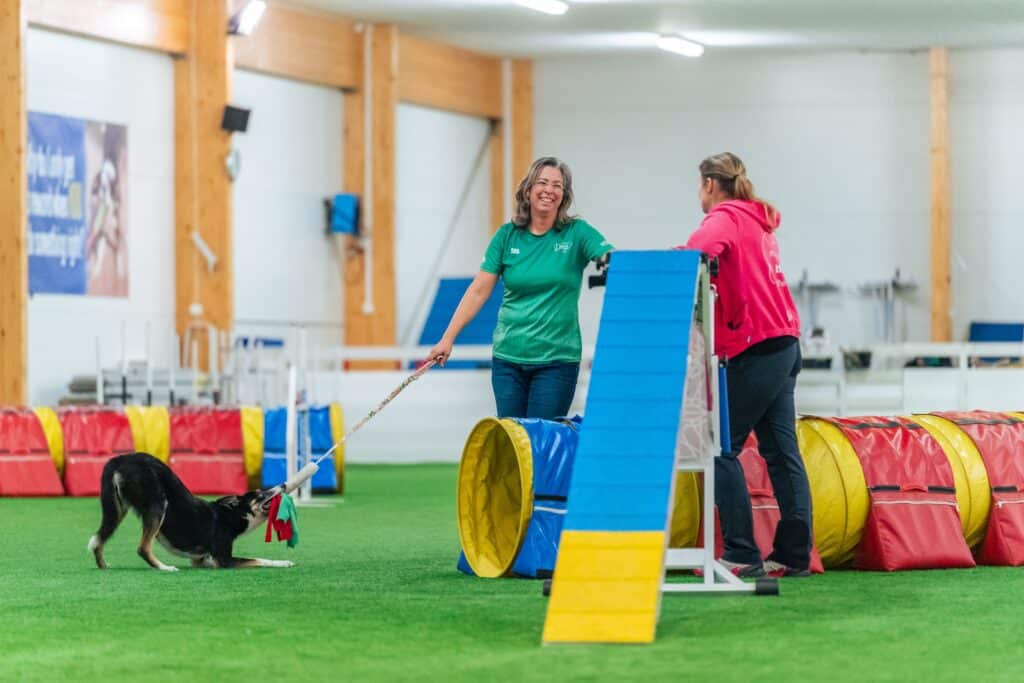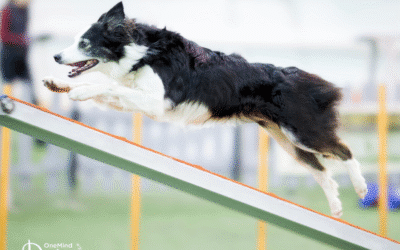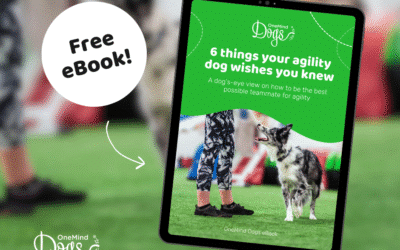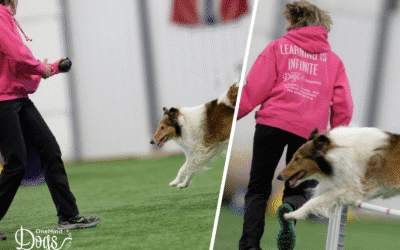Do you suffer from nerves at agility competitions? You’ve probably spent a fair bit of time training your dog’s skills, brushing up on handling techniques, and making sure your teammate is fit and ready. But how much time have you spent training your own mind?
Agility isn’t just about physical skills, it’s a mental game for the human half of the team too. If your brain checks out at the start line, it doesn’t matter how well your dog knows the course. Handling decisions need to happen fast, and conscious thinking is often too slow. Your body and your thoughts need to work together. And to do that, you have to be able to stay calm, focused, and in the moment.
Want help with that? We talk all about this in our free webinar: The mental side of agility: Getting out of your own head.
Ring nerves: friend or foe?
Does your heart pound before a run? Do your hands get a little shaky? Maybe you lose track of where you’re supposed to be after jump four?
That’s called ring nerves—and the truth is, it’s completely normal. A little nervousness is actually a good thing. It means you care. It gets your senses firing and your body ready to go.
But too much nervous energy can tip you over the edge. Suddenly your brain is foggy, your feet feel heavy, and your breathing is all over the place. Your thoughts spiral, your confidence drops, and the tension travels right down the leash to your dog.
It’s a fine balance: some nerves are helpful, but too much will work against you. The key is learning to manage it. A good place to start? Reframing those nerves as excitement. Instead of thinking “I’m scared,” try “I’m ready.”
What we believe matters (even when it’s not true)
Most agility handlers have had thoughts like:
- I’m not good enough for this.
- We haven’t trained enough.
- Everyone else is better than me.
- I always mess up in front of that judge.
These aren’t facts, they’re beliefs. And beliefs can be sneaky. They usually come from past experiences, or even childhood. Over time, they feel like truths. But that doesn’t make them accurate.
The problem is, when you carry around limiting beliefs like “I can’t do this” or “we’ll never succeed,” they affect how you show up on the course. You play small. You hesitate. And you handle half-heartedly. Your dog feels that.
Instead, start to challenge your beliefs. Ask yourself: is this actually true, or just something I’ve been telling myself? If you’ve trained the skills and your dog understands the game, then give yourselves the credit you deserve.
Let’s say you catch yourself thinking, “We never run well under this judge.” Try flipping it: “We’ve trained for this, and we’re capable of handling it, no matter who’s standing in the middle of the ring.”
The way you think shapes how you perform. It’s worth getting those thoughts on your side. Learn more in our Mental Training online course, a free inclusion in Agility Premium!
Control what you can, let go of the rest
Think about your last competition. What went wrong? What went right? And more importantly, what was in your control?
A common mental trap is wasting energy on things you can’t change. The weather. The judge’s course design. The noisy dog in the next ring. The slippery grass.
The reality is, those things will always be there. You can’t control them. What you can control is how you respond.
You get to control how you warm up your dog. How you focus your mind. How you recover after a mistake. And how you support your teammate. That’s your circle of influence. Put your energy there.
Surround yourself with people who help keep you in that mindset, people who lift you up, not drag you down.

The meaning you give things changes everything
Let’s say your dog breaks their startline. What’s your reaction?
One handler might think: “I can’t trust them to stay. Now I’m stressed and unfocused.”
Another might think: “Great, I didn’t train this properly, now everyone’s judging me.”
And a third might smile and say: “Wow, they’re just so excited to be doing agility.”
Same event. Totally different reactions.
That’s because it’s not the event itself causing the emotion, it’s the meaning we attach to it. Your feelings are valid, but they aren’t facts. They’re shaped by how you interpret what happened.
So next time something goes wrong on course, stop and ask yourself: what story am I telling myself right now? And is it helping or hurting?
The goal isn’t to ignore your emotions. It’s to choose a response that keeps you present, calm, and focused on your dog, not stuck in a downward spiral.
Who’s talking in your head?
Most of us have a running commentary in our heads when we train or compete. Some of those voices are helpful. Others… not so much.
Let’s meet a few of the regulars:
- The fortune teller predicts disaster before it happens. “I just know he’ll knock that bar.” “She’ll definitely miss the weave entry.” Most of the time, it’s wrong. But it still throws you off.
- The storyteller reminds you of every past mistake. “We always mess this part up.” “Last time we ran a course like this, we got disqualified.” The past isn’t the present. Let it go.
- The critic is the harsh one. “Why even bother? You’ll never be good enough.” “Everyone’s watching and waiting for you to fail.” It’s loud, and it’s wrong.
The next time you hear a voice in your head during training or a trial, notice who it is. You don’t have to argue with it, just decide if it deserves your attention.
Learn more about this concept in our free webinar here.
The best way to support your dog is to support yourself, too. A kind inner voice goes a long way.
Attitude is everything
You’ve probably heard of a fixed mindset versus a growth mindset. A fixed mindset says: “I’m either good or I’m not. If I fail, it means I’m not cut out for this.” A growth mindset says: “Every mistake is feedback. We’re always learning.”
Agility is unpredictable. Courses change, conditions shift, and even the best dogs can have off days. A growth mindset helps you roll with it. Instead of falling apart after a mistake, you regroup and look for what you can learn.
This doesn’t mean you always have to be positive or ignore frustration. It just means you treat setbacks as part of the journey, not a dead end.
That kind of mindset helps you stay calm under pressure. And when you stay calm, your dog can focus. When you recover quickly, your dog keeps running. When you enjoy the process, your dog enjoys it too.
And isn’t that the point?
Let’s wrap this up
Training your dog’s mental game is important, but so is training your own. Your mindset affects everything: how you show up, how you handle pressure, and how your dog responds to you.
Agility nerves are real, but they don’t have to control you. You can learn to manage them. You can learn to challenge the thoughts that hold you back. And you can become the kind of handler your dog is proud to run with.
If this hits home, take the next step and watch our free webinar: The mental side of agility: Getting out of your own head. It’s full of helpful, relatable tips to help you train your brain just like you train your dog.
Because at the end of the day, agility is about teamwork. And you’re half of that team.



